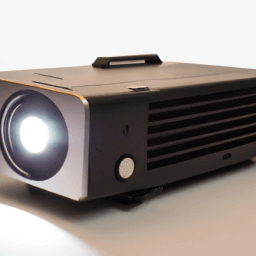What is the best projector type?
The best projector type depends on the specific needs and preferences of the user. However, some popular projector types include DLP (Digital Light Processing), LCD (Liquid Crystal Display), and LCoS (Liquid Crystal on Silicon). DLP projectors offer high contrast and sharp images, while LCD projectors have better color accuracy and brightness. LCoS projectors offer the best of both worlds with high contrast and color accuracy. Ultimately, the best projector type will depend on factors such as budget, room size, and intended use.
What is the Best Projector Type?
Projectors are an essential tool for presentations, movie screenings, and gaming. They are used in various settings, including classrooms, boardrooms, home theaters, and outdoor events. With so many types of projectors available in the market, it can be challenging to determine which one is the best for your needs. In this article, we will discuss the different types of projectors and their features to help you make an informed decision.
LCD Projectors
LCD (Liquid Crystal Display) projectors are the most common type of projectors used in classrooms and boardrooms. They are affordable, easy to use, and provide excellent image quality. LCD projectors work by passing light through three liquid crystal panels that produce red, green, and blue colors. The light is then combined to create a full-color image that is projected onto a screen.
The advantages of LCD projectors include high brightness, sharp image quality, and low maintenance costs. They are also lightweight and portable, making them ideal for presentations on the go. However, LCD projectors have some limitations, such as poor contrast and black levels, which can affect the image quality in dark environments.
DLP Projectors
DLP (Digital Light Processing) projectors use a chip with millions of tiny mirrors that reflect light to create an image. DLP projectors are known for their high contrast and black levels, which make them ideal for home theaters and movie screenings. They also have a fast refresh rate, which reduces motion blur and makes them suitable for gaming.
The advantages of DLP projectors include high contrast, excellent black levels, and fast refresh rates. They also have a longer lifespan than LCD projectors and require less maintenance. However, DLP projectors are more expensive than LCD projectors and can suffer from the "rainbow effect," which can cause some viewers to see flashes of color in the image.
Laser Projectors
Laser projectors use lasers to produce light instead of traditional lamps or bulbs. They are known for their high brightness and color accuracy, making them ideal for large venues and outdoor events. Laser projectors also have a longer lifespan than traditional projectors and require less maintenance.
The advantages of laser projectors include high brightness, excellent color accuracy, and long lifespan. They also have a fast refresh rate and can produce images with high contrast and black levels. However, laser projectors are more expensive than traditional projectors and can be challenging to set up and use.
LED Projectors
LED (Light Emitting Diode) projectors use LED lights to produce light instead of traditional lamps or bulbs. They are known for their low power consumption, long lifespan, and low maintenance costs. LED projectors are also lightweight and portable, making them ideal for presentations on the go.
The advantages of LED projectors include low power consumption, long lifespan, and low maintenance costs. They are also lightweight and portable, making them ideal for presentations on the go. However, LED projectors have some limitations, such as low brightness and color accuracy, which can affect the image quality in bright environments.
Conclusion
Choosing the best projector type depends on your needs and budget. LCD projectors are ideal for classrooms and boardrooms, while DLP projectors are suitable for home theaters and gaming. Laser projectors are ideal for large venues and outdoor events, while LED projectors are ideal for presentations on the go. Consider the brightness, image quality, and maintenance costs when choosing a projector type.
| Projector Type | Advantages | Disadvantages |
|---|---|---|
| LCD Projectors | High brightness, sharp image quality, low maintenance costs, lightweight and portable | Poor contrast and black levels, image quality affected in dark environments |
| DLP Projectors | High contrast, excellent black levels, fast refresh rates, longer lifespan, less maintenance | Expensive, "rainbow effect" can cause flashes of color in the image |
| Laser Projectors | High brightness, excellent color accuracy, long lifespan, fast refresh rate, high contrast and black levels | Expensive, challenging to set up and use |
| LED Projectors | Low power consumption, long lifespan, low maintenance costs, lightweight and portable | Low brightness and color accuracy, image quality affected in bright environments |
| By www.zelect.in | ||
Sharing is caring!
Facebook Twitter Email
Recommended articles for Projector
Projector types and buying guide
-
Understanding Projector Refresh Rate: What You Need to Know
-
The Benefits of 4K Projectors: Crisp and Detailed Image Quality
-
What is HDR projector? What are the advantages and disadvantages of HDR projectors?
-
The Advantages of Ultra-Short Throw Projectors
-
Projector Screen Size Guide: Selecting the Perfect Dimensions
-
What is DLP projector? What are the advantages and disadvantages of DLP projectors?
-
What is ultra short throw projector? What are the advantages and disadvantages of ultra short throw projectors?
-
What is a short throw projector? What are the advantages and disadvantages of LCD projectors?
-
Choosing the Right Projector Mount: Ceiling or Wall?
-
Projector Image Quality: Factors to Consider
-
Projector vs. Smart TV: Which is the Better Entertainment Option?
-
What is LED projector? What are the advantages and disadvantages of LED projectors?
-
What is hologram projector? What are the advantages and disadvantages of hologram projectors?
-
What is a laser projector? What are the advantages and disadvantages of laser projectors?
-
Projector buying guide. How to Choose the Right projector for your needs?
-
Understanding Projector Throw Ratio and Image Size
-
Projector Keystone Correction: What is it and How to Use it
-
The Rise of Laser Projectors: Advantages and Limitations
-
Projector Screens: Which Type is Right for You?
-
Projector vs. TV pros and cons. Which is the Better Option?
-
A Comprehensive Guide to Projector Lumens and Brightness?
-
What are the advantage and disadvantage of projector?
-
Understanding Projector Contrast Ratio What You Should Know?
-
Compare projector contrast ratio vs lumens
-
How many lumens is best for projector during day?
-
What is lumens in projector?
-
What is the best projector type?
-
What are the different types of projectors? Their uses?


